| |
|
|
|
Thomas Brown
Private First Class
H&S CO, 3RD BN, 9TH MARINES, 3RD MARDIV, III MAF United States Marine Corps New York, New York February 11, 1947 to May 20, 1967 THOMAS BROWN is on the Wall at Panel 20E, Line 55 See the full profile or name rubbing for Thomas Brown |
 |

|
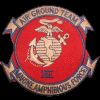
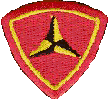
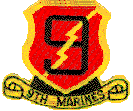
| |
|
02 Jan 2007
I worked with Tom at Citibank after I got out of the Air Force in early 1965. Knowing I was a vet, Tom was very inquisitive and I was happy to fill him in on the experiences of basic, overseas stations, etc. After I left the Bank I met Tom on Wall Street in 1966. He was in Marine Dress Uniform and said he was headed over. I wished him luck and told him to call me when he got back. It was a friendly parting and our last. I think about him whenever I see pictures of The Wall. From a friend,Frank Biscay bisc928@aol.com |
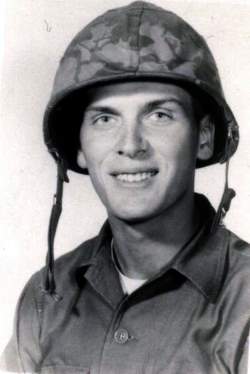
Since 27 February 1967, U.S. Marine positions in the vicinity of the DMZ in the area of Con Thien and Gio Linh, had been subjected to almost daily mortar, rocket, and artillery attacks. On 8 May, two enemy battalions attacked marine units near Con Thien, within a half mile of the DMZ. Since that time, there were several enemy probes and company sized ground attacks against the Marine units in that area. The period had been characterized by intense combat. Since 8 May, 392 of the enemy were killed but 82 Marines were killed in action with 354 Marines wounded. The enemy had been using the DMZ area as a sanctuary, from which to conduct his mortar and rocket attacks and launch their intensive ground attacks. On 8 May, the Commander, US Military Assistance Command, Vietnam (USMACV) was finally authorized to conduct ground operations in the southern half of the DMZ. During the period 17-28 May 1967, the 3rd Marine Division was permitted for the first time to conduct search and destroy operations within the southern of the DMZ north on Con Thien and Gio Linh, and east of the Dong Ha mountains. Operation Hickory was conducted in coordination with the Special Landing Force (SLF) 1st Battalion, 3rd Marines' (1/3) Operation Beau Charger and the ARVN Operation Lam Son 54. From Marine operation reports, mid May, the following entry identified the participating units in Operation Hickory (Third Marine Division): The 9th Marines with six infantry battalions (Second Battalion, twenty sixth Marines; first and third battalions, 4th Marines; and the first and second battalions, Ninth Marines;) and the third Marines, with the third battalion, 9th Marines commenced a coordinated search and destroy operation in conjunction with Beau Charger (Special Landing Force (SLF) Alpha-Battalion Landing Team (BLT) 1/3 HMM 164)) and LAM SON 54 (1st ARVN Division with 6 battalions) in North Eastern Quang Tri Province, with significant contact for the period. The Allied attack was to be supported by a massive Navy-Marine-Air Force effort, the landing of SLFs Alpha and Bravo, and a parallel sweep by the 1st ARVN Division - all headed into the DMZ. Read all the details of Operation Hickory Battles here. On 20 May, 1845 hours, Company K, point for the 3rd Battalion, 9th Marines (acting as a screen for the left flank of Operation Hickory units), made heavy contact with an estimated enemy company deployed in prepared positions to include mutually supporting bunkers in vicinity of grid coordinates YD 104644. Initial casualties were six Marines killed in action with 51 USMC wounded in action. The battle lasted late into the evening and early morning hours. The 3/9 was the battalion screening the western flank of the units in Operation Hickory. To relieve pressure on Company K, Company L was maneuvered to the flank of the enemy position, but was unable to link up with Company K because of heavy enemy fire. The enemy used machine guns, grenades, and 60 mm mortars. Air Strikes were called. Both companies spent the night on opposite sides of the draw with the enemy force between them, while supporting arms pounded the enemy positions all night. As of 211300 hours, the battalion reported that the contact continues with unknown size enemy force. Artillery and Air support continued and casualties now reported as 26 KIA with 59 WIA. A news paper clipping reporting the death of PFC Hartsoe indicated that it was unknown whether he was in the initial phase of Operation Hickory when 10,000 American and ARVN troops were sent into action, or part of the reserve forces sent in later due to the heavy contacts. Operation Hickory terminated at 28 2400H with 119 USMC KIA, 817 WIA, with 362 enemy KIA and 38 detainees. The Americans had flown 1,006 Air Sorties and used Naval Gun Fires for 67 missions. Killed were 25 sailors and Marines from the 3rd Battalion, 9th Marines in heavy fighting on 20 May 1967. Those killed during the contact were:
The citations for the Silver Star of Cpl Walter J. Washut, and Navy Crosses for LCpl David G. Bendorf and Pfc David E. Hartsoe, gives you an idea of the intense battle conditions these Marines faced. 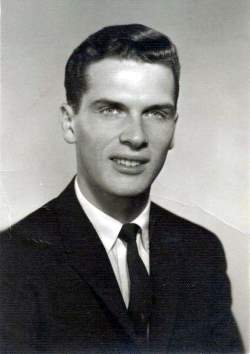
Thomas E. Brown was survived by his mother Catherine Mary Doran Brown (1911-1972), father Walter Joseph Brown (1912-1989), and brother Walter, all in Bronx New York. PFC Thomas E. Brown is buried in Saint Raymonds Cemetery (New), Bronx, New York, along with his mother and father.
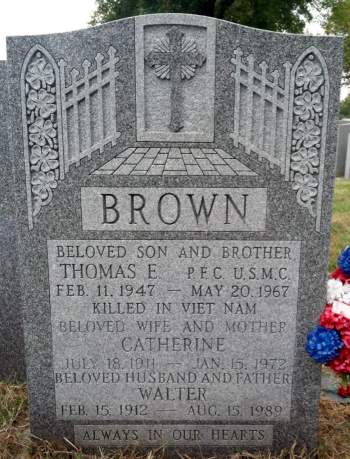
- - - The Virtual Wall, February 12, 2018 |
Notes from The Virtual WallThe North Vietnamese Army had two divisions stationed in the Demilitarized Zone, and a third just north of the DMZ. These forces were supported by heavy artillery based in and north of the DMZ, and were free to cross into South Vietnam as they wished, withdrawing into the sanctuary of the DMZ when necessary. In late Spring of 1967 the United States government changed its policy with respect to the DMZ and authorized MACV to allow US military operations in the southern half of the DMZ.OPERATION HICKORY was the immediate result and was in response to thrusts south by elements of the two NVA Divisions. HICKORY was intended to defeat NVA units operating south of and within the portion of the DMZ up to (but not across) the Ben Hai River. One of the forces employed was the 3rd Battalion, 9th Marines, recently withdrawn from operations west of the Khe Sanh Combat Base. In the eastern sector, HICKORY was successful in forcing the NVA to withdraw north of the Ben Hai River, in removing some 11,000 civilians from the disputed areas, and in destroying the NVA infrastructure south of the Ben Hai - but that success came at a high cost. On 20 May, Kilo 3/9, point for the battalion, made contact with what it initially estimated to be an enemy platoon deployed in mutually supporting bunkers in a draw. The enemy, at least a company, took Kilo under fire. To relieve pressure on Kilo, Lima 3/9 maneuvered to the flank of the enemy position, but was unable to link up with Kilo because of heavy enemy fire. Both companies spent the night on opposite sides of the draw with the enemy force between them, while supporting arms pounded the enemy position all night. On the 21st, Mike 3/9 moved forward, joining with Kilo and Lima, and the three companies were able to clear the area. The clearing operation was costly: 26 Marines were killed and 59 wounded. The Marines counted only 36 enemy bodies, but the lingering smell in the draw indicated that many others were in the destroyed fortifications. |
| Contact Us | © Copyright 1997-2019 www.VirtualWall.org, Ltd ®(TM) | Last update 08/15/2019 |